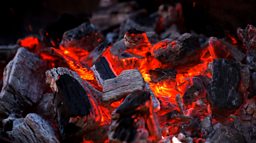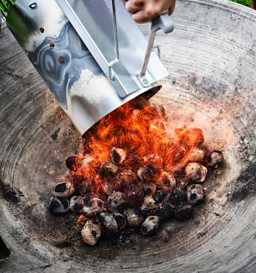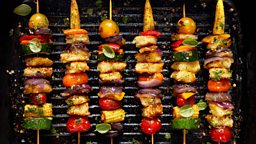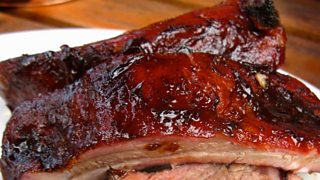11 sizzling tips for BBQing like a pro
Rain or shine, the British barbecue is a summer tradition. But it’s not the easiest of culinary crafts. Thankfully, in a special episode of The Food Programme, Sheila Dillon is joined by a band of grilling and charring experts for a BarbeQ'n'A. They offer up more tips than you could shake a sausage at, to help all our al fresco feasts go with a bang. Here are some of our favourites, with a few extras thrown in for good measure.

1. Get a chimney starter
Getting the barbecue lit can be one of the greatest challenges facing an al fresco chef. Top tip? Get yourself a chimney starter (also known as a charcoal chimney). This piece of apparatus looks like a huge metal jug with a grate rather than a solid bottom. Fill the chimney with charcoal, which sits on the grate near the bottom of the cylinder, and place newspaper underneath. Lighting the paper will then ignite the charcoal stacked above. Once all the charcoal is burning (after about ten minutes), lift the chimney by its handle and pour the burning charcoal into your barbie. Voila!
2. Use natural firelighters and charcoal
The charcoal we buy from the supermarkets often has chemical accelerants in it which taints the taste of the food we’re grilling. Genevieve Taylor – food stylist, presenter and author of How to Eat Outside – says not only that, but mass-market charcoal invariably comes from the tropics and isn’t sustainable. Look for British charcoal, made in the most environmentally friendly way possible. If you’re going to use firelighters avoid a chemical taste by seeking out natural ones made from wood shavings dipped in wax.
3. Add herbs to your coals for a flavour injection
For something a bit different, toss some herbs directly on to your charcoal (once the flames have died down). Go for a robust herb like sage, rosemary, or thyme as these will stand up to the heat better than coriander or basil. Soaking them first so they’re damp also means they’ll smoke for longer and release more flavour into your food.

The charcoal from supermarkets often has chemical accelerants in it which taints the taste of the food we’re grilling and isn't sustainable.
4. Toss on some wood chips
Adding wood chips to your coals is another great way to add layers of smoky flavour to your food. Different woods produce different aromas so you can even pair your wood with your meat, fish or veg. For instance, apple wood smoke has a subtle sweet and fruity flavour, so it’s great for when you’re cooking chicken or fish. Oak smoke, on the other hand, has a more robust flavour, which goes well with all meats.

5. Marinate for healthier meat
Charring your meat does have some downsides. Cooking at high temperatures breaks the meat proteins down in such a way that they generate molecules that are carcinogens. A way to reduce this is to marinate your meat first. If a marinade contains an acid – like wine, vinegar, or citrus fruit – that acidity changes the surface chemistry of the meat and minimises the production of those dangerous molecules. It also tenderises the meat and makes it taste good too!
6. Try barbecuing bigger chunks of meat
We tend to stick to small cuts like chicken wings and chops, but there are advantages to cooking heftier cuts of meat on the barbecue. It’s much harder to cook it to a cinder for starters! Samantha Evans, one half of the barbecuing duo The Hang Fire Girls, recommends a rump cap – traditionally a Brazilian cut of meat that has a good coverage of fat to keep it moist, whilst packing plenty of flavour. Because it has thinner and thicker parts you can please those who like their meat well done as well as those who prefer it medium-rare.
7. When we’re talking burgers, fat means flavour
Christian Stevenson, AKA DJ BBQ, is a presenter, barbecue fanatic and author of The Burger Book. He says the key to a flavoursome patty is lots of fat so look for mince that is 20 to 35 percent aged beef fat. Cook on a flat plate, rather than directly on the grill, and smash your burger. This creates cracks around the outside that allows the fat to render, creating little fjords of flavour. No need to add eggs or breadcrumbs either – just season and let the meat do the talking. (Although brushing some mustard on while you’re cooking can give it a helping hand.)
8. Don’t be scared to BBQ veggies
Sliced butternut squash, aubergine, and sweet potato all make wonderful, tasty alternatives to burgers or steaks. But pretty much any veg does well on the grill. London-based chef, restaurateur and food writer Yotam Ottolenghi says throwing your fresh peas, beans and other greens on a hot griddle or barbecue and leaving them to char is the best thing you can do with them. He suggests making a light dressing from Dijon mustard, sour cream, garlic, olive oil and lemon juice to drizzle on top, with a sprinkling of shaved parmesan or pecorino cheese.
What's the best way to build your own BBQ?

How you can best go about building your own fire pit or BBQ.
What to do with fish on the BBQ

Helpful advice about how best to barbecue fish.
Pretty much any veg does well on the grill. Throwing veg on a hot griddle or barbecue and leaving them to char is the best thing you can do with them.
9. For vegan burgers, use a pan
Vegan burgers that work a treat in the oven have the propensity to fall apart on the barbeque. The simple solution is avoid cooking directly on the grill and use a pan or flat plate. Your burger gets the smoky flavour without losing its composition. Also, ground linseed has a similar texture to egg white when it’s moist so sprinkling that into your burger will help it to bind. To increase the barbecue flavours, try grilling the beans or butternut squash you’re going to use to make your burger before mashing them and moulding them into shape.

10. Dessert on the barbie
Who said you couldn’t do dessert on the barbie? Stone fruits like nectarines, peaches and plums work wonderfully roasted over the coals and served up with mascarpone and honey or a healthy dollop of ice cream. Or to make your own toffee apples hollow out an apple, fill it with toffee pieces or raisins and brown sugar, put it in a foil parcel and throw it straight on the embers. Other pudding options include fruit kebabs and sweet pizzas, with chocolate spread instead of cheese. And don't forget putting a whole banana on there, in its skin, with slices of dark chocolate poked inside the middle.
Add robust herbs like sage, rosemary, or thyme to your charcoal. Soak them first so they'll release more flavour.
11. Continue to use the BBQ as it's cooling down
OK, so you’ve cooked all your barbecue food, but don’t waste what heat is left in those coals. Throw some garlic bulbs in to the embers as they’re smouldering, or a handful of potatoes. You can then use these the next day to make smoky mash, hash or some really good chips.
-
![]()
The Food Programme: The BarbeQ'n'A
Sheila joins a group of grilling gurus to address listeners’ barbecue queries.
-
![]()
The Food Programme: Barbecue
Dan Saladino explores one of the food world's most misunderstood words - barbecue.
-
![]()
Lessons from a BBQ champion
Jay Rayner speaks to barbecue enthusiast John Hargate about his competition plans.
-
![]()
The Crafty Beer Quiz
Craft beer names can get faintly ridiculous. Can you tell which of these are real?




